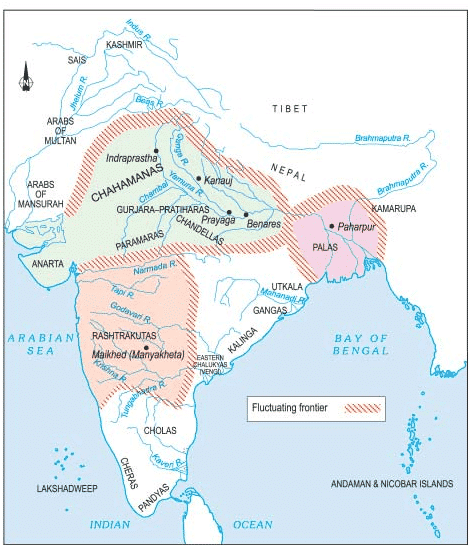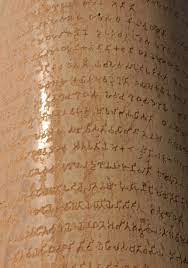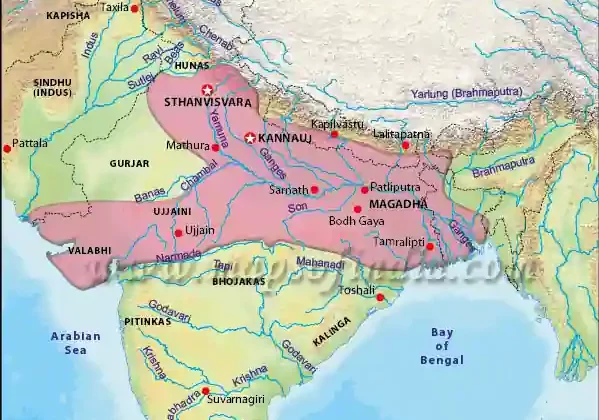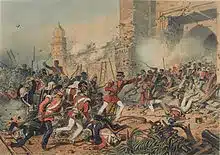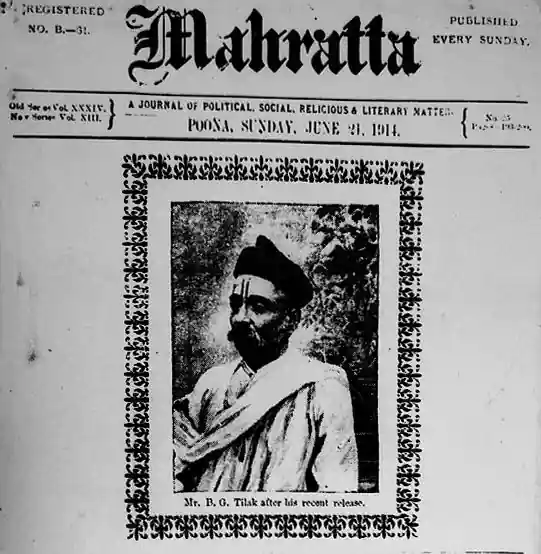Ancient Indian Potteries
An archaeological culture is studied by applying pottery analysis in archaeology because pottery is durable and survives at the archaeological sites long after other items have decayed or perished. Different types of potteries in ancient India are given below :
| Harappan Age | Black and Red Ware; Black on Red Ware |
| Early Vedic Period | Ochre Coloured Pottery (OCP) |
| Later Vedic Period | Painted Grey Ware (PGW) |
| Pre-Mauryan Age | Northern Black Polished Ware (NBPW) |
| Mauryan Age | NBPW |
| Post – Mauryan Age | Red Ware |
| Gupta Age | Red Ware |
Ochre Coloured Pottery culture
- Ochre Coloured Pottery culture (OCP) is a 2nd millennium BC Bronze Age culture (roughly 2600 BCE to 1200 BCE) of the Indo-Gangetic Plain, extending from eastern Punjab to northeastern Rajasthan and western Uttar Pradesh.
- The OCP pottery has a red slip and appears ochre in colour (the ochre colour comes off when the pottery is touched) and hence, it is called Ochre Coloured Pottery. It has black painted designs.
- The OCP comes in the form of jars, storage jars, bowls, and basins.
- This OCP culture was almost contemporary to the latter half of the Mature Harappan civilization and may have had some associations with early Vedic culture.
- The OCP sites produced copper figures and objects and therefore it is also known as “copper hoard culture.”
- It is a rural culture and has evidence of the cultivation of rice, barley, and legumes. They also had pastoralism with evidence of cattle, sheep, goats, pigs, horses, and dogs. The villages had wattle-and-daub houses. They used copper and terracotta ornaments. Animal figurines have also been found.
Black and red ware culture
- Black and Red Ware (BRW) is sandwiched between OCP and Painted Grey Ware (PGW).
- Black and Red Ware are distinct pottery characterized by two surface colours: black on the interior and outer rim and red on the exterior.
- This colour combination was produced by inverted firing.
- Black and red ware culture (BRW) is a late Bronze Age and early Iron Age archaeological culture of the northern and central Indian subcontinent, associated with the Vedic civilization.
- In the Western Ganges plain (western Uttar Pradesh) it is dated to c. 1450-1200 BCE, and is succeeded by the Painted Grey Ware culture; whereas in the Central and Eastern Ganges plain (eastern Uttar Pradesh, Bihar, and Bengal) and Central India (Madhya Pradesh), the BRW appears during the same period but continues for longer, until c. 700-500 BCE when it is succeeded by the Northern Black Polished Ware culture. In the Western Ganges plain, the BRW was preceded by the Ochre Coloured Pottery culture.
- The BRW sites were characterized by subsistence agriculture (cultivation of rice, barley, and legumes), and yielded some ornaments made of shell, copper, carnelian, and terracotta. In some sites, particularly in eastern Punjab and Gujarat, BRW pottery is associated with Late Harappan pottery.
- Harappan’s Age Potteries: The potteries found at the excavation sites can be broadly classified into two kinds – plain pottery and painted pottery. The painted pottery is also known as Red and Black Pottery as it used red colour to paint the background and glossy black paint was used to draw designs and figures on the red background. The potteries were used for three main purposes:
- Plain pottery was used for household purposes, mainly the storage of grains and water.
- Miniature vessels, generally less than half an inch in size, were used for decorative purposes.
- Some of the potteries were perforated – with a large hole in the bottom and small holes across the sides. They might have been used for straining liquor.
Symbols Of 5 Great Events Of Buddha’s Life
Painted Grey Ware
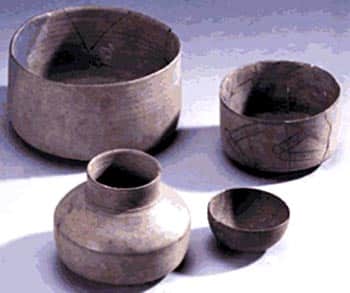
- The Painted Grey Ware (PWG) culture is an Iron Age culture of the western Gangetic plain and the Ghaggar-Hakra valley, lasting from roughly 1200 BCE to 600 BCE, which probably corresponds to the middle and late Vedic period, i.e., the Kuru-Panchala kingdom, the first large state in South Asia after the decline of the Indus Valley Civilization.
- It is a successor of the Black and red ware culture (BRW) within this region, and contemporary with the continuation of the BRW culture in the eastern Gangetic plain and Central India.
- The Painted Grey ware sites reveal the development of agriculture and pastoralism, and the settlements of this period grew in dimension. They show a large scale population increase in the northern part of India. The Iron Age in North India was coeval with Painted Greyware Culture, and in South India, it was associated with Megalithic burial mounds.
- The Painted Grey Ware cultural phase is followed by Northern Black Polished Ware culture (NBPW), which is associated with the Mahajanapada and Mauryan periods.
Northern Black Polished Ware
- Northern Black Polished Ware (abbreviated NBPW or NBP) is an urban Iron Age culture of the Indian Subcontinent, lasting c. 700–200 BCE, succeeding the Painted Grey Ware culture and Black and red ware culture.
- It developed beginning around 700 BC, in the late Vedic period, and peaked from c. 500–300 BC, coinciding with the emergence of 16 great states or mahajanapadas in Northern India, and the subsequent rise of the Mauryan Empire.
- The pottery of the Mauryan period is generally referred to as Northern Black Polished Ware (NBPW). They were characterised by the black paint and highly lustrous finish and were generally used as luxury items. They have often been referred to as the highest level of pottery.
Red Polished Ware (Gujarat)
- The Red Polished Ware (RPW) is found in great quantities in Gujarat, especially in the Kathiawar region. Commonly, it consists of domestic forms like cooking pots, and it dates to around the first century BC.
- Early Red Polished Ware is often associated with the Northern Black Polished ware (NBP) and goes back to the 3rd century BC.
Important Court Poets Of India
Important facts about Ancient Indian potteries :
- The earliest evidence of pottery has been found in the Neolithic site of Mehrgarh, now situated in Pakistan.
- The most famous pottery from the ancient period is the Painted Grey Ware pottery, which is typically grey in colour and was related to the Vedic period (1000-600 BC).
- In some parts of the country, evidence of red and black pottery can be found that has been dated to 1500-300 BC. These were found in large parts of West Bengal.
- Another type of ancient pottery was the Northern Black Polished Ware, which was made in two phases: first in 700-400 BC and next during 400-100 BC.
- These phases partially coincided with the Mauryan period. Furthermore, in the southern parts of India, we find remnants of ‘Roulette Pottery’ that can be dated to 200-100 BC.
- Most of the evidence has been found from Arikamedu near Puducherry.
- Red and black pottery was famous during Harappan Civilisation.
- Painted grey ware was during the Vedic period.
- The potteries of the Indus Valley Civilisation can be broadly classified into two kinds – plain pottery and painted pottery. The painted pottery is also known as Red and Black Pottery as it used red colour to paint the background and glossy black paint was used to draw designs and figures on the red background. Trees, birds, animal figures and geometrical patterns were the recurring themes of the paintings.
- The pottery of the Mauryan period is generally referred to as Northern Black Polished Ware (NBPW). They were characterised by black paint and highly lustrous finish and were generally used as luxury items.
Also refer :


